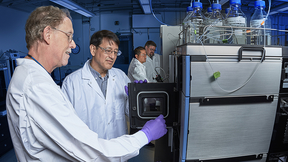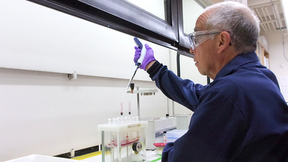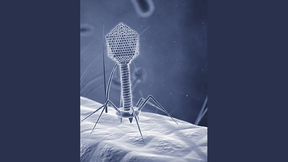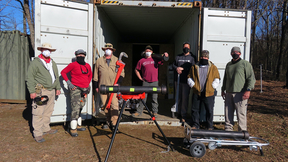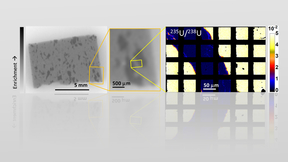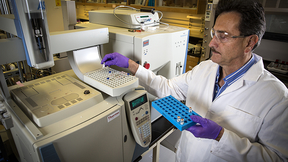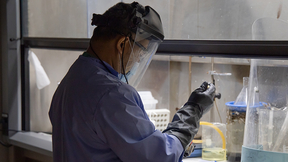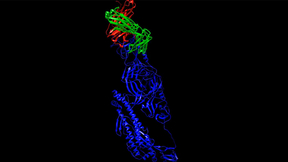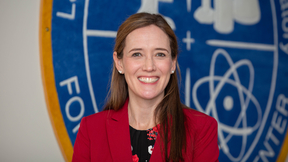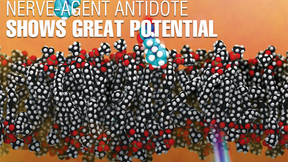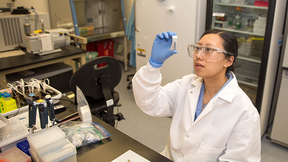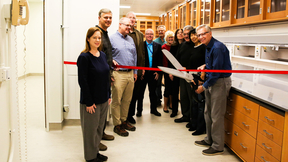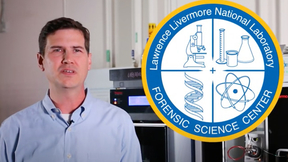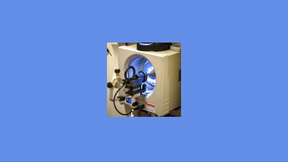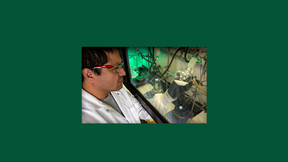Back
Forensic Science Center
Big Ideas Lab podcast visits the Forensic Science Center: part 2
Lawrence Livermore National Laboratory’s Forensic Science Center (FSC) is a unique place. It is the only forensic science center in the United States that could accept a truly mixed hazard sample — with a biological material, a chemical agent, explosives and nuclear material. It is one of only two laboratories in the United States — and among 30 in the world — that is…
LLNL and Purdue University accelerate discovery of medical countermeasures for emerging chemical threats
In a major advance for chemical defense and public safety, scientists at Lawrence Livermore National Laboratory’s (LLNL) Forensic Science Center (FSC) and Purdue University have developed and demonstrated a high-throughput, automated mass spectrometry platform. Their platform dramatically accelerates the discovery of medical countermeasure candidates against A-series…
Big Ideas Lab podcast delves into Forensic Science Center cases, podcast nears milestone
In May 1999, Bulgarian customs officials seized a vial containing a small amount of highly enriched uranium (HEU) at a checkpoint on the Bulgarian/Romanian border. The material, about four grams of HEU, was hidden in a shielded lead container inside the trunk of a car being driven by a Turkish citizen. The driver had first attempted to sell the material in Turkey and then…
LLNL researchers discover promising treatment to counteract the effects of fentanyl for overdose cases
A team of Lawrence Livermore National Laboratory (LLNL) researchers has discovered a promising new treatment to counteract the effects of fentanyl and related opioids. The new treatment could, over time, be a boon to doctors and medical professionals dealing with the crisis of fentanyl, a drug whose lethal effects has killed more than 210,000 Americans during the past…
Forensic Science Center to mentor Moroccan lab
Researchers from Lawrence Livermore National Laboratory’s (LLNL) Forensic Science Center (FSC) will assist a national laboratory from the North African nation of Morocco under an international program over the next year. As an Organisation for the Prohibition of Chemical Weapons (OPCW)-designated laboratory for more than two decades, LLNL will work with a Moroccan lab –…
LLNL Forensic Science Center team develops new technique to analyze fentanyl in blood and urine
A team of Lawrence Livermore National Laboratory (LLNL) scientists has developed a new technique to analyze fentanyl in human blood and urine samples that could aid work in the fields of medicine and chemical forensics. Led by Carlos Valdez, an LLNL synthetic chemist and lead author, the team discussed its new fentanyl analysis approach in a paper recently published in the…
LLNL garners 'A' grade in OPCW environmental test
Even after taking highly stressful exams in college, grades can still be important. Just ask researchers at Lawrence Livermore National Laboratory’s (LLNL) Forensic Science Center (FSC). Every fall, chemists and other researchers from the FSC spend two weeks of long days undertaking the Organisation for the Prohibition of Chemical Weapons (OPCW) environmental proficiency…
Fighting Bacterial Infections with Machine Learning
Scientists in the Forensic Science Center at Lawrence Livermore have partnered with San Diego State University and UCSD to advance bacteriophage therapy.
LLNL weapon engineers, biologists deliver critical samples to identify skin proteins left on IEDs
Following a terrorist bombing, can the bomb maker be identified by skin proteins left on the bomb components they handled? To address this question, Lawrence Livermore National Laboratory (LLNL) personnel from Weapons Complex Integration (WCI) and Global Security (GS) Forensic Science and Biosecurity Centers (FSC/BSC) subjected notional bomb components handled by LLNL…
Lab analysis reveals forensic signatures of nuclear material during international smuggling exercise
Lawrence Livermore National Laboratory (LLNL) scientists received mock evidence, consisting of two uranium oxide (UO2) fuel pellets, as part of an international nuclear forensic exercise in support of a simulated nuclear smuggling investigation. The exercise was part of the CMX-5 Collaborative Materials Exercise organized by the Nuclear Forensics International Technical…
The Worldwide Effort to Ban Chemical Weapons
The Forensic Science Center is an important ally in the international endeavor to prohibit chemical warfare agents.
Lab earns 'A' grade in OPCW test
In another month-and-a-half, a score of chemists from Lawrence Livermore National Laboratory's Forensic Science Center (FSC) will start two weeks of long days to undertake the Organization for the Prohibition of Chemical Weapons (OPCW) environmental proficiency test. Livermore chemists have been taking the proficiency tests each October since 2001, with LLNL serving as one…
Lab antibody, anti-viral research aids COVID-19 response
Lawrence Livermore National Laboratory (LLNL) scientists are contributing to the global fight against COVID-19 by combining artificial intelligence/machine learning, bioinformatics and supercomputing to help discover candidates for new antibodies and pharmaceutical drugs to combat the disease. See the visualization Backed by five high performance computing (HPC) clusters…
Forensic scientist wins 'outstanding' early career award
A chemist who is the director of Lawrence Livermore National Laboratory’s (LLNL) Forensic Science Center is the recipient of the 2020 “Outstanding Early Career Achievement in Forensic Science Award.” The award, given to LLNL’s Audrey Williams, is presented annually by the American Academy of Forensic Sciences (AAFS) Past Presidents Council. This year’s award will be…
Nerve-Agent Antidote Shows Great Potential
Scientists at LLNL’s Forensic Science Center and Biosecurity Center have formulated molecule LLNL-02, the first molecule capable of dual protection against nerve agents.
LLNL-led study finds any single hair from the human body can be used for identification
Any single hair from anywhere on the human body can be used to identify a person. This conclusion is one of the key findings from a nearly year-long study by a team of researchers from Lawrence Livermore National Laboratory’s (LLNL) Forensic Science Center (FSC) and Michigan State University. The team’s study, published in Scientific Reports, a journal of Nature Magazine,…
More than a facelift: Lawrence Livermore's radiochemistry labs receive extensive upgrades
Lawrence Livermore National Laboratory (LLNL) continuously upgrades facilities and equipment on the main campus. Infrastructure investments help ensure that scientists, engineers and support staff carry out LLNL’s mission safely and effectively. Building 151 is the latest site of extensive renovations. Construction recently finished in four laboratory spaces, combining two…
S&TR Preview: Forensic Science Boosts Global Security
The FSC guides the field toward more objective techniques and data-driven results.
Constant Vigilance in Forensic Science
Bruce Warner, Associate Director for Global Security at LLNL, describes the FSC’s contribution to advances in science and technology.
The Case for Modern Forensic Science
Armed with wide-ranging expertise and analytical capabilities, FSC scientists are prepared for anything that comes through its doors.






